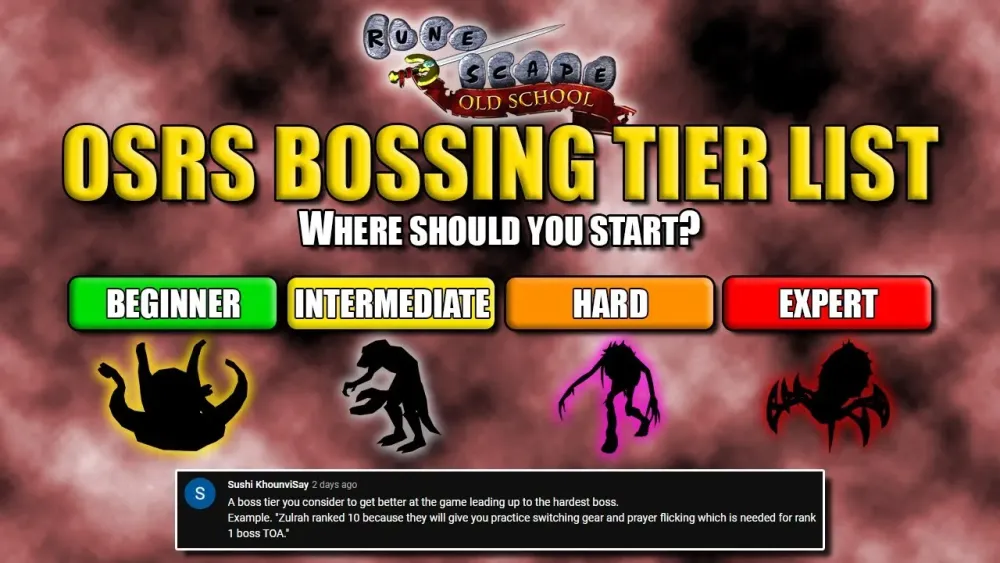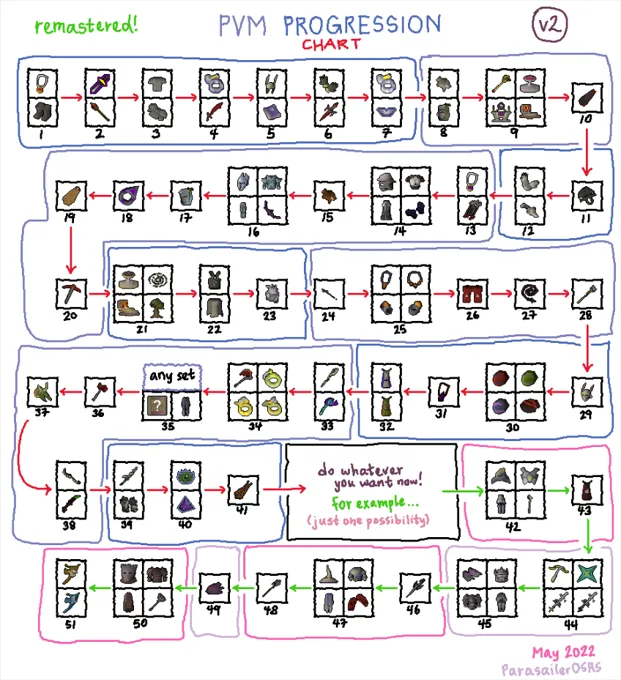Your cart is empty
Ultimate OSRS Boss Tier List: Ranking the Most Challenging Encounters

Old School RuneScape (OSRS) features a diverse array of bosses that challenge players with varying levels of difficulty. From the iconic General Graardor to the fearsome Vorago, these encounters require skill, strategy, and teamwork. Understanding the complexities of each boss is crucial for players aiming to conquer them. This article presents a comprehensive tier list, ranking the most challenging OSRS bosses based on specific criteria, helping players prioritize their encounters and enhance their gameplay experience.
When ranking the bosses of OSRS, several key criteria are considered to ensure a fair and accurate assessment of their difficulty. These criteria include mechanics, damage output, required gear and skill levels, and overall encounter length.
Mechanics: The complexity of a boss’s mechanics plays a significant role in determining its difficulty. Bosses with multiple attack styles, environmental hazards, or unique mechanics that require specific strategies to counter are ranked higher. For example, bosses like the Theatre of Blood’s Verzik Vitur have intricate mechanics that can easily overwhelm unprepared players.
Damage Output: A boss’s ability to inflict damage is another critical factor. Bosses that deal high damage per second (DPS) require players to maintain high levels of awareness and quick reflexes to avoid being overwhelmed. Encounters like the Nightmare and the Corporeal Beast are notorious for their high DPS, making them formidable challenges.
Required Gear and Skill Levels: The level of gear and skill required to effectively tackle a boss greatly influences its ranking. Some bosses can be defeated with relatively low combat stats and basic gear, while others require top-tier equipment and high combat levels. For instance, the Inferno demands near-perfect gear and a high level of skill, placing it among the most challenging bosses in the game.
Overall Encounter Length: The duration of the battle also impacts a boss’s difficulty ranking. Longer encounters often require sustained focus and resource management, increasing the challenge. Bosses like the Abyssal Sire can take considerable time to defeat, requiring players to maintain concentration and manage their supplies effectively throughout the fight.
By evaluating these criteria, players can better understand which bosses pose the greatest challenges and prepare accordingly for epic encounters in OSRS.
S-Tier Bosses: The Ultimate Challenges

When it comes to Old School RuneScape (OSRS), the S-Tier bosses represent the pinnacle of combat challenges. These encounters not only test your skills and strategy but also reward you with some of the best loot in the game. If you’re looking to push your limits and prove your prowess, these bosses are where you should focus your efforts.
To give you a clearer picture, here’s a breakdown of the S-Tier bosses:
- Zulrah: A unique serpent boss that requires players to adapt to different attack phases. Mastering Zulrah’s mechanics can yield valuable rewards, including the coveted Tanzanite and Magma mutagens.
- Scorpia: Known for her challenging mechanics and the risk of PvP encounters in the Wilderness, Scorpia drops the powerful Scorpion’s Kiss and other valuable items.
- The Nightmare: This boss brings a whole new level of complexity with its mechanics and phases. The Nightmare drops unique weapons and armor sets, making it a favorite for high-level players.
Each of these bosses requires a combination of skill, knowledge of mechanics, and sometimes even teamwork. Players must be prepared with the right gear, supplies, and strategies to take on these ultimate challenges. If you can conquer an S-Tier boss, you’ll earn not just loot, but bragging rights in the OSRS community.
A-Tier Bosses: Strong Contenders
A-Tier bosses in OSRS are formidable opponents that provide a great challenge without reaching the extreme difficulty of S-Tier encounters. While they may not be the absolute toughest, they still demand respect and strategic preparation. These bosses are excellent for players looking to hone their skills or test their mettle without the overwhelming pressure of S-Tier battles.
Here’s a quick overview of the A-Tier bosses:
- Vorkath: This dragon boss combines powerful attacks with unique mechanics like zombie minions. Defeating Vorkath rewards players with valuable drops, including the Dragonfire Ward and Vorkath’s head.
- Kraken: An iconic boss found in the depths of the ocean, the Kraken can be a great source of unique drops like the Kraken Tentacle and the coveted Magic Fang.
- General Graardor: As the leader of the Bandosian forces, Graardor is a challenging encounter that requires good gear and teamwork. He drops powerful items like the Bandos Chestplate and Tassets.
While the A-Tier bosses may not be the hardest in OSRS, they are still highly rewarding. Players can expect to improve their skills and enjoy significant rewards from these encounters, making them a worthwhile endeavor in the game.
B-Tier Bosses: Moderately Challenging
The B-Tier bosses in Old School RuneScape (OSRS) provide a balanced challenge for players who have honed their skills but may not yet be ready to tackle the most difficult encounters. These bosses require a good understanding of mechanics, timing, and strategy, but they aren’t overwhelmingly punishing. Here’s a closer look at what makes these bosses moderately challenging.
Some characteristics of B-Tier bosses include:
- Solid Mechanics: B-Tier bosses introduce players to more complex mechanics that require awareness and adaptability.
- Group Dynamics: Many of these fights are best tackled with a team, promoting teamwork and coordination.
- Gear Requirements: Players should come prepared with decent gear and supplies, but they won’t need the absolute best equipment.
Examples of B-Tier bosses include:
| Boss Name | Location | Key Mechanics |
|---|---|---|
| Venenatis | Wilderness | Spiderlings, Webs |
| Scorpia | Wilderness | Poison Attacks |
| Cerberus | Tears of Guthix Cave | Hellhounds, Fire Attacks |
These bosses offer a suitable challenge for players looking to refine their skills and tactics without overwhelming frustration. They also provide valuable loot and experience, making them worthwhile encounters on your journey through Gielinor.
C-Tier Bosses: The Easier Fights
C-Tier bosses in OSRS are considered the easier fights, ideal for players who are newer to the game or looking for a less stressful bossing experience. These bosses often have straightforward mechanics and can be tackled solo or in small groups without the need for extensive preparation.
Key features of C-Tier bosses include:
- Simpler Mechanics: The fights typically involve basic attack patterns and minimal environmental hazards.
- Lower Gear Requirements: Players can approach these bosses with lower-level gear and still succeed.
- Quick Fights: These encounters are generally faster, allowing players to get in and out without a significant time investment.
Some C-Tier bosses you might encounter are:
| Boss Name | Location | Key Mechanics |
|---|---|---|
| Giant Mole | Falador | Burrowing, Mole Minions |
| King Black Dragon | Wilderness | Fire Breath, Spawned Minions |
| Barrows Brothers | Barrows | Special Attacks |
These bosses serve as a great way to practice combat skills, test out new gear setups, and enjoy the bossing experience without the intensity of higher-tier fights. Whether you’re farming for loot or just looking to unwind, C-Tier bosses can be a fun and rewarding option.
7. Tips for Defeating High-Tier Bosses
Defeating high-tier bosses in Old School RuneScape (OSRS) can be a daunting task, but with the right strategies and preparation, you can improve your chances of success. Here are some tips to help you conquer these formidable foes:
- Know Your Boss: Each high-tier boss has unique mechanics and attack patterns. Spend some time researching their abilities to understand how to counter them effectively.
- Gear Up Properly: Equip yourself with the best gear you can afford. Focus on maximizing your damage output while ensuring you have sufficient defensive capabilities. A good balance is crucial.
- Use Potions Wisely: Potions can make a significant difference in your performance. Bring Saradomin brews for healing, Super restore potions for prayer, and other relevant potions for damage boosts.
- Bring the Right Supplies: Stock up on food, potions, and runes (if applicable). Having enough supplies can make or break your encounter.
- Practice Makes Perfect: Consider practicing on lower-tier bosses to refine your combat skills and familiarizing yourself with boss mechanics.
- Team Up: Some bosses are easier to defeat with a group. Teamwork can help distribute damage and control the encounter better.
- Adjust Your Strategy: If a tactic isn’t working, don’t hesitate to change your approach. Flexibility can lead to better results.
By following these tips and staying adaptable, you’ll increase your chances of overcoming even the toughest high-tier bosses in OSRS.
8. Conclusion: Finding Your Bossing Strategy
Finding your own bossing strategy in OSRS is like embarking on a thrilling adventure. It requires experimentation, patience, and a willingness to learn from each encounter. Here’s how you can hone in on a strategy that works for you:
- Assess Your Playstyle: Are you more of a solo player or do you thrive in a team? Understanding your strengths and preferences can guide your choice of bosses and strategies.
- Experiment with Different Bosses: Don’t be afraid to try out various bosses. Each one offers a unique challenge and can help you develop your skills.
- Evaluate Your Gear: Your equipment plays a huge role in your effectiveness as a boss fighter. Make sure you’re utilizing the best gear available to you, and consider upgrading as you progress.
- Review and Learn: After every boss encounter, take a moment to reflect on what went well and what didn’t. Adjust your strategy based on these insights.
- Stay Updated: The OSRS community is always evolving. Follow updates, patches, and player discussions to keep your strategy fresh and relevant.
Ultimately, your bossing journey in OSRS is about finding what resonates with you. Whether you prefer the thrill of soloing or the camaraderie of group play, developing your personal bossing strategy will lead to greater success and enjoyment in the game.

